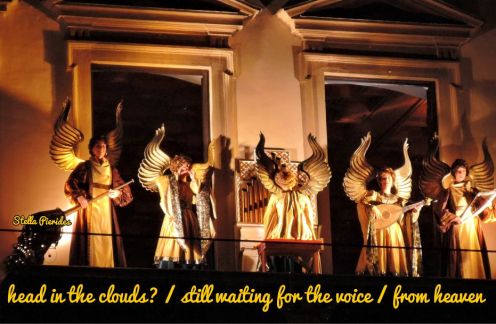catching
the last rays. . .
buttercups
From my walk along the Schmutter
Photo of bridge over the Schmutter, Neusaess
*
that look on her face . . .
a feather stuck
to the egg
.
Prompt: question
catching
the last rays. . .
buttercups
From my walk along the Schmutter
Photo of bridge over the Schmutter, Neusaess
*
that look on her face . . .
a feather stuck
to the egg
.
Prompt: question
olive press
in the Cretan mountains
liquid gold
.
Prompt: oil
still life
a gull breaks
the silence

This is a photo I took of Konstanz harbour, on Lake Constance, or Bodensee, as it is also known in Germany.
wikipedia entry for Lake Constance:
http://en.wikipedia.org/wiki/Lake_Constance
nature’s numbers
the infinite sweetness
of cup-shaped blooms
marmelada
my tongue savours
the word
.
Prompt: marmalade
lighthouse
one cold wave
after another
.
Prompt: liquid
head in the clouds?
still waiting for the voice
from heaven
.

Prompt: kickbacks
Photo: 29 November 2014 in Augsburg. First Advent, the Engelspiel, at the marketplace.
There is a video of this event (Engelspiel) from previous years here
Also a description of the Christmas market, or Christkindlesmarkt, as it is called, here
winter stew…
releasing the gist
of the story
.
NaHaiWriMo prompt: kitchen
.
birds in and out of sunday noon rain
.
NaHaiWriMo prompt: knack
sunset years
the effort of sitting up
straight
.
NaHaiWriMo prompt: King (?)
new mother —
unwrapping a gift without
instructions
.
NaHaiWriMo prompt: jargon
broken mirror…
autumn gusts ripple
the lake
.
NaHaiWriMo prompt: jinxed
forget-me-nots
the well-thumbed corners
of my diary
.
NaHaiWriMo prompt: journal
jacuzzi jets
two kids make space
for their granny
.
NaHaiWriMo prompt: jet
night chill…
all the refugees asleep
behind bars
.
NaHaiWriMo prompt: Jail
moon jelly
the slow beating
of your heart
For moon jelly see here
berries falling down…
scents from the marsh floor
all jumbled up
.
NaHaiWriMo prompt: jumble
growing pains —
the destroying angel
under the bell jar
.
NaHaiWriMo prompt: jar
For ‘destroying angel’ see here
lost in thought —
a train thunders past
stubble fields
.
NaHaiWriMo prompt: infinite
the short glide
into autumn —
hermit ibis
.
NaHaiWriMo prompt: ibis
their stories
in my bones —
harvest moon
.
NaHaiWriMo prompt: inherit
dream ivy
clinging without
clinging
.
NaHaiWriMo prompt: ivy
Recently I visited the Frank Auerbach display of 15 paintings and 29 drawings at the Tate Britain, selected by his fellow painter and friend, Lucian Freud. The collection was offered by the Lucian Freud estate, and accepted by the British Government, in lieu of inheritance tax.
The group of paintings is of international artistic importance and a good ’teaser,’ anticipating a major Tate retrospective planned for 2015.
A fine group of works, including one of my favorites, Rebuilding the Empire Cinema, Leicester Square, 1962.
What a fantastic, bold show of both, imagination and brushwork, deep feeling and insightful depiction of psychologically layered scenes. The same subjects — Julia, his wife; Estella, his mistress; Jake, his son; Mornington Crescent — visited again and again, let the viewer get intimately acquainted with, as well as intrigued by them. Born in 1931 in Berlin, Auerbach came to England in 1939 and has lived and painted in London since. A London painter, and a painter of London, Auerbach has gone under the skin of the capital, making it the prime set of his work. If not Auerbach, then who else captures the energy and multifarious burdens carried by London’s inhabitants so realistically?
In an interview by Hannah Rothschild, Auerbach, from what has been his tiny home and studio since 1954, opens up about his work and life. Surprisingly, a sparse and spare studio and frugal life are juxtaposed to and contrasted with his many-layered, rich encrustations of paint in his work. The charcoal paintings are also ‘rich’ in depth and insight that feels both, inquiring and haunting. I left the room intrigued by his work, troubled, and at the same time, strangely satisfied by his profound achievement. Reading Rothschild’s interview later, I found this which rang true:
“So why does Auerbach paint the same face, the same view over and over again? Wouldn’t it be interesting to try a new landscape or a different nose? Auerbach shakes his head. ‘The closer one is to something, the more likely it is to be beautiful,’ he says. ‘The whole business of painting is very much to do with forgetting oneself and being able to act instinctively. I find myself simply more engaged when I know the people. They get older and change; there is something touching about that, about recording something that’s getting on.’ Amid the frenzy of paint and energy it can be hard to spot the person in an Auerbach portrait. ‘Likeness is a very complicated business indeed,’ he says. ‘If something looks like a painting it does not look like an experience; if something looks like a portrait it doesn’t really look like a person’.”
Well, here’s food for thought.
peas in a pod —
thick brushwork layers
the light
.
The interview can be found here